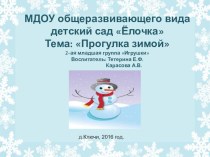- Главная
- Разное
- Бизнес и предпринимательство
- Образование
- Развлечения
- Государство
- Спорт
- Графика
- Культурология
- Еда и кулинария
- Лингвистика
- Религиоведение
- Черчение
- Физкультура
- ИЗО
- Психология
- Социология
- Английский язык
- Астрономия
- Алгебра
- Биология
- География
- Геометрия
- Детские презентации
- Информатика
- История
- Литература
- Маркетинг
- Математика
- Медицина
- Менеджмент
- Музыка
- МХК
- Немецкий язык
- ОБЖ
- Обществознание
- Окружающий мир
- Педагогика
- Русский язык
- Технология
- Физика
- Философия
- Химия
- Шаблоны, картинки для презентаций
- Экология
- Экономика
- Юриспруденция
Что такое findslide.org?
FindSlide.org - это сайт презентаций, докладов, шаблонов в формате PowerPoint.
Обратная связь
Email: Нажмите что бы посмотреть
Презентация на тему Realia
Содержание
- 2. Realia (plural noun) are words and expressions for culture-specific material things.
- 3. The word realia comes from medieval Latin,
- 4. There are different terms for references specific
- 5. According to Florin, REALIA give a source-cultural
- 6. Classifications of realia
- 7. Realia may be classified in several ways.
- 8. The thematic category covers ethnographical realia, i.e.
- 9. The geographical category includes realia that belong
- 10. From the point of view of time, realia can be either modern or historical.
- 11. In Florin’s classification the same realia could
- 12. TABLE 1Classification of realia (Nedergaard-Larsen 1993).Extralinguistic culture-bound problem types
- 14. Nedergaard-Larsen’s classification does not take into account
- 15. Recently, Pedersen (2005, 2007) has studied proper
- 16. TABLE 2Names in the classification of realia.
- 18. Realia and ways of translating them
- 19. To translate realia, various strategies exist : they
- 20. There are following methods of conveying the meaning of realia:
- 21. 1. By Transcription or Transliteration ExclusivelyThese realia
- 22. 2 By Transcription or Transliteration and Explication
- 23. 3. By Descriptive Explaining/Explication OnlyWhen the transcription/transliteration
- 24. 4. By Translation of Componential Parts and
- 25. 5. By Ways of Word-for-word or Loan
- 26. Скачать презентацию
- 27. Похожие презентации
Realia (plural noun) are words and expressions for culture-specific material things.



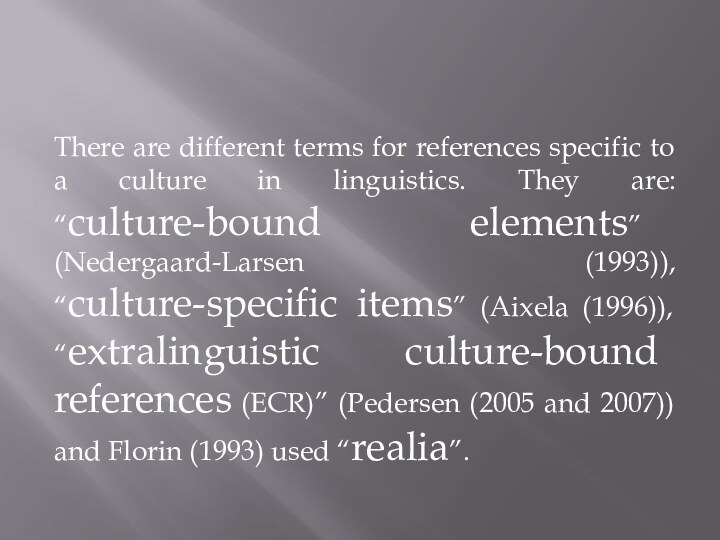







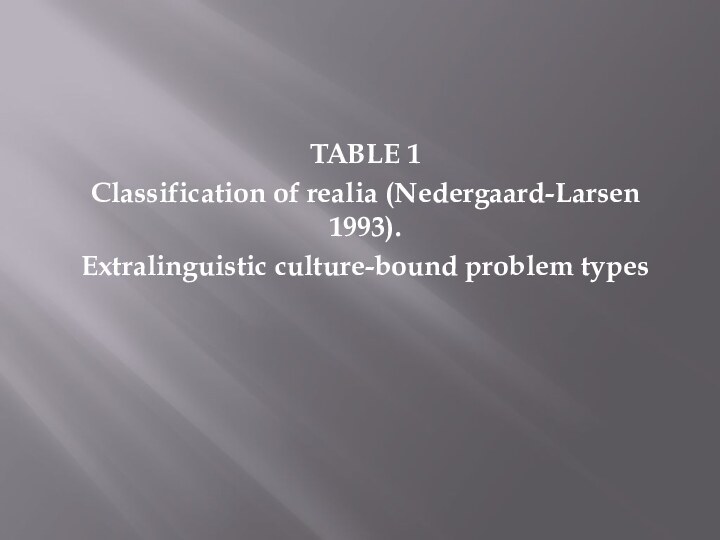

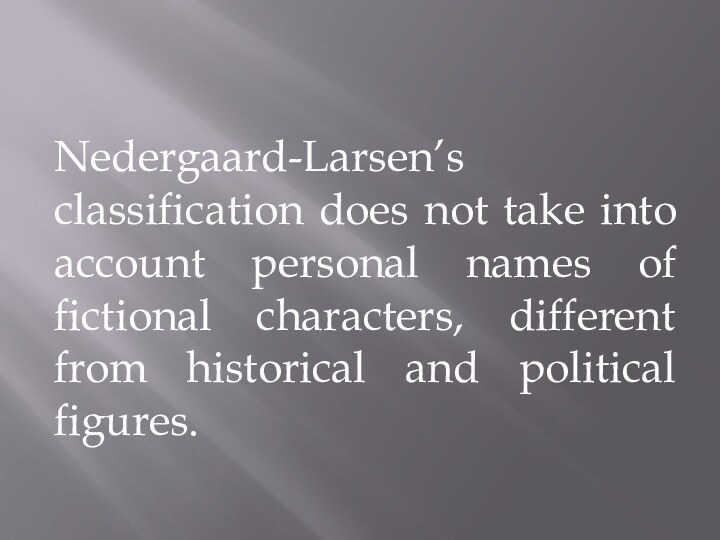


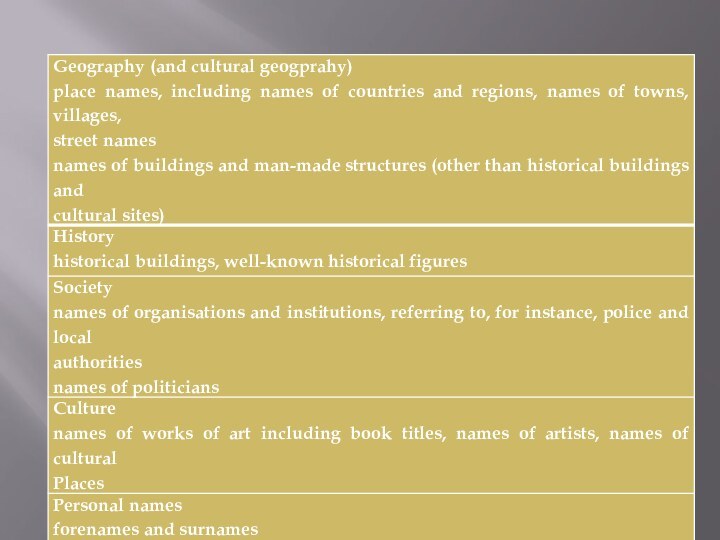









Слайд 3 The word realia comes from medieval Latin, in
which it originally meant “the real things”, i.e. material
things, as opposed to abstract ones. The Bulgarian translators Vlahov and Florin, who were the first to carry out an in-depth study of realia considered that REALIA must not be confused with terminology, which is primarily used in the scientific literature, and usually only appears in other kinds of texts to serve a very specific stylistic purpose. Realia, on the other hand, are born in popular culture, and are increasingly found in very diverse kinds of texts. Fiction, in particular, is fond of realia for the exotic touch they bring.Слайд 4 There are different terms for references specific to
a culture in linguistics. They are: “culture-bound elements” (Nedergaard-Larsen
(1993)), “culture-specific items” (Aixela (1996)), “extralinguistic culture-bound references (ECR)” (Pedersen (2005 and 2007)) and Florin (1993) used “realia”.Слайд 5 According to Florin, REALIA give a source-cultural flavour
to a text by expressing local and/or historical colour,
and so realia do not have exact equivalents in other languages. As an example of realia, Florin mentions things like samovars and concepts like samizdat.
Слайд 7
Realia may be classified in several ways.
Florin
classifies realia:
• thematically, according to the material or logical
groups they belong to;• geographically, according to the locations in which they are used;
• temporally, according to the historical period they belong to.
Слайд 8 The thematic category covers ethnographical realia, i.e. realia
that belong to everyday life, work, art, religion, mythology,
and folklore of a culture (e.g. First of May and Valentine Day), and social and territorial realia (e.g. state and canton – округ у Швейцарії).Слайд 9 The geographical category includes realia that belong to
one language only (subcategories: microlocal realia, local realia, national
realia, regional realia and international realia) and realia alien to both languages (realia that do not belong either to the source or the target culture).Слайд 11 In Florin’s classification the same realia could be
categorised in different ways, depending on whether their thematic,
geographic or temporal aspect is emphasised. For example, the Ukrainian borsch (traditional soup) as both ethnographical and national realia, belonging to the modern times as well as to history.
Слайд 12
TABLE 1
Classification of realia (Nedergaard-Larsen 1993).
Extralinguistic culture-bound problem
types
Слайд 14 Nedergaard-Larsen’s classification does not take into account personal
names of fictional characters, different from historical and political
figures.Слайд 15 Recently, Pedersen (2005, 2007) has studied proper names,
including both non-fictional and fictional personal names, alongside with
other types of realia. Similarly, for instance, Davies (2003) and Aixela (1996) deal with proper names, including not only geographical names (e.g. names of towns and streets) but also personal names, in their analyses of realia.
Слайд 19
To translate realia, various strategies exist : they range
from phonetic transcription to translation of the overall meaning.
Scholars offer one way of defining such solutions. According to the characterization, each of these can be placed between two extremes: adequacy (closeness to the original) and acceptability (making the word entirely consistent with the target culture).
Слайд 21
1. By Transcription or Transliteration Exclusively
These realia usually
belong to genuine internationalisms and comprise social and political
units of lexicon in the main (lord lady, mister, hryvnia etc)e.g. “It’s a poor coloured woman’s place and you are a grand gentleman from Cape Town” – ця кімната для бідної кольорової жінки, а ти ж великий джентельмен з Кейптауна
Слайд 22 2 By Transcription or Transliteration and Explication of
Their Genuine Nationally Specific Meaning
In many cases the
lingual form of realia conveyed through transcription or transliteration can not provide a full expression of its lexical meaning. Then an additional explication of its sense becomes necessary. It happens when the realia are introduced in the Target Language for the first time or when the realia are not yet known to the broad public of the Target Language readers. The explanation may be given either in the translated passage/speech flow, where the realia are based, or in a footnote — when a lengthy explication becomes necessary: e.g. They took her to the Tower of London. — Вони показали їй стародавню лондонську фортецю Тауер.He said that Wall Street and Threadneedle Street between them could stop the universe. — він сказав, що Волл-Стріт і Треднідл-Стріт 1удвох спроможні зупинити всесвіт
1 Треднідл-Стріт – вулиця в лондонському Сіті, де розташовані кілька головних банків Великобританії
A number of restaurants and cafeterias in Kyiv specialize in varenyky (dumplings), kulish (a thick meal stew) and other dishes. — У Києві чимало ресторанів та кафетеріїв, що спеціалізуються на приготуванні вареників, кулішу та інших страв
Слайд 23
3. By Descriptive Explaining/Explication Only
When the transcription/transliteration can
not be helpful in expressing the sense of realia
or when it might bring about an unnecessary ambiguity in the Target Language narration/text explications and explaining are used. No coffins were available, so they wrapped George in a blanket and in the Union Jack —У них не було готових домовин, тож вони замотали Джорджа у ковдру та у прапорВеликої БританіїСлайд 24 4. By Translation of Componential Parts and Additional
Explication of Realia
The proper meaning of some realia can
be faithfully rendered by way of regular translation of all or some of their componential parts and explication of the denotative meaning pertaining to the source language unit. Such and the like explanations can not, naturally, be made in the text of a translation, hence they are given usually in the footnotes, as in the following example: Well, I can tell you anything that is in an English bluebook, Harry’ (O. Wilde) —«Ну, я тобі можу розповісти все, що написано в англійській 2«Синій книзі»2 «Синя книга» – збірник документів, що видається з санкції парламенту Великої Британії в синіх палітурках
When the lexical meaning of the realia is not so complex, it is usually explained in the Target Language text. The explanation then of course, is not always as exhaustive as it call Dc in a foot note. e g Keep you fingers crossed for me’ (M Wilson) —Щоб мені була вдача, склади навхрест (хрестиком) пальці!






















